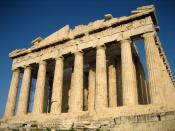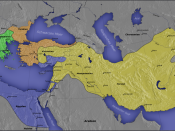Greek sculpture and developments
From the evidence we have, relics of Greek sculpture begin to appear around the middle of the 7th century, became an established institution by the beginning of the 6th century and continued until the beginning of the Hellenistic period in the 4th century when the form had been clearly established and artists began to imitate and copy the achievements of previous sculptors. (Cook 74) From the first appearance of Greek sculpture a clear trend towards exploring and depicting the anatomy of the ideal human body can be observed. This depiction of the perfect human form appears to be the primary orientation of Greek sculpture.
Although the Greeks had been creating various statuettes, geometric designs, and pottery before the 7th century, these creations were merely decorative objects and there is rarely any evidence of stone sculpture. However, a distinctive change occurs in the middle of the seventh century as the first large-scale statues appear.
The strongest evidence for the sudden emergence of this new activity points towards an Egyptian influence. In the middle of the 7th century, Egypt conquered Assyria and as a result the Greeks were allowed to set up a trading town in the Nile delta. This trading post allowed them to establish and maintain closer and more continuous contact with the Egyptians than before. (Boardman 72) Right around the same time that the trading town had been established, the Greeks begin to create stone sculptures. A look at the first life-size Greek sculpture of ayoung boy, known as a kouros, in comparison with an Egyptian sculpture around the same time demonstrates the profound influence that Egyptian art had on the Greek mind.
From these images it is clear, as Boardman writes, that "the next phase of Greek sculpture owed much to the arts...



Informative
Very well written about the piece of art as well as its history amazing
0 out of 0 people found this comment useful.